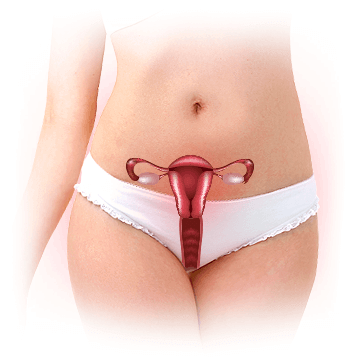Ovulation
Ovulation occurs roughly midway through a healthy menstrual cycle, and it is the only time conception can occur.
Ovulation Cycle

During monthly ovulation cycles, an egg matures in one of the ovaries to then be released on the ovulation day and travel through the fallopian tubes to the uterus.
This journey takes about 24 hours, during which the egg is capable of being fertilized if the sperm is present in the tubes. If fertilization does not occur, the egg is shed along with the uterine lining, resulting in a period about two weeks later.
Since the sperm can survive in the reproductive tract for up to 5 days, having unprotected sex three to five days before the ovulation day can result in successful conception. This short period is referred to as the fertile window.
Ovulation Signs & Symptoms
Because of natural shifts of estrogen, progesterone, luteinizing hormone (LH), and follicle-stimulating hormone (FSH) throughout the cycle, ovulation can be confirmed based on specific signs and symptoms.
Ovulation Symptoms
Mild pelvic or lower abdominal pain
Increased libido
Bloating
Breast tenderness
Light vaginal spotting
Moodiness
Ovulation Signs
- Cervical mucus: becomes clear and sticky, resembling egg whites
Basal Body Temperature (BBT): slightly drops before ovulation and rises 0.4-1.0 °F (0.2 - 0.5 °C) afterwards
- Cervical position: becomes soft, moist, and open and moves higher up into the body
LH levels: start to surge 24-36 hours before ovulation and peak at 25- 40 mlU/mL on ovulation day
- Ferning patterns: form in the saliva due to rising progesterone following ovulation
Ovulation Tests
There are various home ovulation tests that can help women prepare to conceive by determining if they are approaching ovulation. They include:
- Measuring BBT
- Checking cervical mucus
- Checking cervical position
- Using ovulation test kits and ovulation microscopes
Ovulation Predictors
Before getting pregnant, women are advised to track their ovulation and menstrual cycles for several months. This can be done with the help of various ovulation predictors, such as ovulation calendars, calculators, trackers, or monitors, ranging from simple pen-and-paper diagrams and print-out fertility charts to online applications and physical devices.
These predictor tools can also help diagnose common ovulation problems, such as anovulation, which is defined as lack of ovulation, or oligoovulation characterized by irregular ovulatory cycles.
Click on the following link to learn more about ovulation or continue to the next section for a better understanding of fertility.
Fertility
A woman's fertility, which is defined as the state of being able to conceive children, depends on several factors.
Ovarian Reserve

Ovarian reserve is the number of eggs stored in the ovaries at any given time. Women are born with a fixed number of eggs, which serves as their lifetime supply.
From birth until puberty, the number decreases by up to 75% from one or two millions. From puberty onwards, a certain number of eggs mature in the ovaries during each menstrual cycle, but only one egg is released during ovulation to be fertilized. If two or more are released, it results in twin or triplet pregnancies.
Fertility and Age
Fertility and age go hand in hand. As a woman ages, her ovarian reserve declines at various rates, and so does her fertility. Generally, fertility is at its peak in early and mid-20s and slowly decreases thereafter.
Fertility at 35. In early 30s, fertility begins to slowly decline, taking a significant dip around the age of 35 - 37 due to decreasing egg reserve and egg quality. Having natural and healthy pregnancy after 35 is, however, very much feasible.
Fertility at 40. Since the menopausal transition typically begins in mid 40s, women might experience irregular periods and low ovarian reserve. Consequently, pregnancy after 40 and 45 is possible, but it might be substantially more challenging.
Fertility comes to a gradual end with menopause, a point in time when a woman has gone without a period for 12 consecutive months due to complete ovarian reserve depletion.
Infertility
Infertility is defined as an inhibited ability to conceive and carry pregnancy to full term. It differs from sterility, which is diagnosed when conception cannot occur because of lack of ovulation or sperm production due to genetics, disease, or injury.
Female infertility is mainly due to low ovarian reserve as well as abnormal ovulation or fallopian tube damage from an ectopic pregnancy or endometriosis.
- Male infertility mostly concerns sperm abnormalities, all which might be caused by various medical conditions, like infections, unhealthy habits, and hormonal imbalances.
Contrary to sterility, infertility can often be treated to enable conception. Possible infertility treatments include fertility pills and injections, surgery, or lifestyle habits. Some couples, however, have to resort to using advanced reproductive technologies (ARTs), such as IVF or artificial insemination.
Fertility Tests
Couples are advised to undergo fertility tests if they failed to conceive after having sex without birth control for 12 months (if a woman is under 35) or 6 months (if a woman if over 35).
Fertility tests might include a physical exam, blood tests, ultrasounds, and diagnostic procedures, all of which are designed to reveal the potential cause of infertility by testing the levels of reproductive hormones, evaluating the state of the ovarian reserve, or ruling out other abnormalities.
Fertility Preservation
Fertility preservation consists of methods to save the eggs and reproductive tissues for future pregnancies. These options include embryo or oocyte cryopreservation, gonadal shielding, or ovarian transposition.
Women might undergo preservation procedures to delay getting pregnant due to personal lifestyle choices as well as medical conditions, like endometriosis, lupus, and cancer, or treatments for them, which are known to inhibit fertility.
Boost Fertility
As a woman is preparing to have a baby, she can optimize her chances of conceiving with healthy lifestyle practices. The best natural fertility boosters include:
Fertility diet rich in zinc, iron, or calcium can improve cervical mucus, regulate ovulation, and resolve ovulatory infertility. Good fertility-friendly foods include eggs, full-fat dairy products, and plant-based protein as well as plenty of water.
Healthy habits, such as managing stress through meditation or mindfulness and getting enough sleep, can promote healthy ovulation. Avoiding addictions to cigarettes and alcohol can also reverse harmful effects of nicotine and alcohol on hormonal production, which affects egg quality and ovulation cycle.
Fertility exercise, such as yoga or swimming, can help women reduce obesity, achieve a healthy weight, and increase the blood flow to the reproductive organs. Strenuous exercise such as weight lifting should be avoided as it might disrupt the menstrual cycle, making it harder to conceive.
Fertility vitamins and supplements can increase the odds of getting pregnant by acting directly on the body systems to bring about hormonal and nutritional balance:
Phytoestrogenic herbal supplements, such as those containing dong quai, chasteberry, or black cohosh, encourage estrogen balance to ultimately regulate ovulation, support uterine function.
Hormone-balancing supplements, such as Macafem, nourish the endocrine and pituitary glands to stimulate natural hormone production, increasing libido and making conception more feasible.
Fertility vitamins and minerals can increase the thickness of uterine lining and reduce the risk of miscarriages, include zinc, vitamin E, con-enzymeQ10, or omega-3 fatty acids.
Other alternative therapies for fertility, such as acupuncture, can improve ovulation, increase blood flow to the uterus, and relieve the negative effects of cortisol levels on female reproductive system.
Pre-Pregnancy Planning
The best outcome is achieved when a woman starts preparing for pregnancy three to six months before conceiving.
Preconception Check-Up

Meeting with a doctor prior to conceiving is a good way to start pre-pregnancy planning.
A typical preconception check up might include a physical exam to evaluate a woman's overall health, weight, and vaccination status as well as blood tests to rule out nutritional deficiencies and STDs and to ensure chronic conditions are under control.
Some couples might need to undergo preconception genetic testing if one of the parents has a medical condition that can be passed down to a child, such as sickle cell disease. Genetic counseling enables prospective parents to understand the mechanism of gene transfer and all involved risks before conceiving.
Pre-Pregnancy Vitamins & Minerals
A woman preparing to have a baby should get proper pre-pregnancy vitamins and minerals mainly from a wholesome preconception diet, which she can complement with supplements, if needed.
Pre-Pregnancy Macronutrients
- Healthy fats: nuts, seeds, and cold water fish
- Complex and fiber-rich carbohydrates: spinach, apples, full-fat dairy, and whole grains
- Lean animal and vegetable protein: eggs, fish, beans, and tofu
Pre-Pregnancy Vitamins & Minerals
- Iron: poultry, spinach, fish, and beans
- Folate (folic acid): beans and leafy green vegetables
- Calcium: yogurt, whole milk, and cheese
- Omega-3 fatty acids: nuts, flaxseed, and cold water salmon
- Vitamin C: tomatoes, kiwi, and bell peppers
Pre-Pregnancy Medical Conditions
Because certain diseases might potentially reduce fertility or cause complications during pregnancy, such as miscarriage or preeclampsia, one of the main focuses of preconception care is controlling them before getting pregnant.
A number of uncontrolled conditions are known to throw off hormonal balance, inhibit menstruation, and damage the reproductive organs, all which might make it difficult or even impossible for women to conceive.
The most common medical conditions that should be managed before conceiving to avoid further complications include:
Certain infectious diseases can also compromise a woman's conception efforts or be passed to the fetus and threaten his health. They include human immunodeficiency virus (HIV), herpes simplex, hepatitis, and other sexually transmitted diseases (STDs).
During the preconception check-up, a doctor can assist a woman in creating a thorough action plan for managing her conditions before getting pregnant and relieving bothersome symptoms. Various effective preconception approaches might include medical treatments, such as medications or surgical procedures, and natural options, like a nutritious diet, adequate exercise, or other healthy lifestyle habits.
Click on the following link to learn the most important steps of pre-pregnancy planning.
Conclusions
Women who take the time to learn how to prepare for pregnancy ahead of time have lower rates of fertility problems or other complications. The idea of preconception care is quite simple. It involves regulating ovulation, optimizing fertility, and improving overall health. Many of these pre-pregnancy goals can be achieved with a diet rich in fertility-boosting foods, such whole grains or healthy fats, hormone-balancing supplements, like Macafem, and moderate exercise, such as yoga. All efforts dedicated to preparing your body for pregnancy will soon pay off once you have your healthy baby in your arms.
Sources
- American College of Obstetricians and Gynecologists. (2014). Female Age-Related Fertility Decline. Retrieved August 3, 2018 from https://www.acog.org/Clinical-Guidance-and-Publications/Committee-Opinions/Committee-on-Gynecologic-Practice/Female-Age-Related-Fertility-Decline
- American Pregnancy Association. (2018). Female Fertility Testing. Retrieved August 3, 2018 from http://americanpregnancy.org/infertility/female-fertility-testing/
- American Pregnancy Association. (2018). Signs of Ovulation. Retrieved August 3, 2018 from http://americanpregnancy.org/getting-pregnant/signs-of-ovulation/
- American Pregnancy Association. (2018). Male Infertility. Retrieved August 3, 2018 from http://americanpregnancy.org/infertility/male-infertility/
- American Society for Reproductive Medicine. (n.d.). Infertility. Retrieved August 3, 2018 from https://www.reproductivefacts.org/topics/topics-index/infertility/
- Frontiers in Publish Health. (2017). Urinary Luteinizing Hormone Tests: Which Concentration Threshold Best Predicts Ovulation? Retrieved August 3, 2018 from https://www.ncbi.nlm.nih.gov/pmc/articles/PMC5712333/
- Mayo Clinic. (2016). Fertility preservation: Understand your options before cancer treatment. Retrieved August 3, 2018 from https://www.mayoclinic.org/healthy-lifestyle/getting-pregnant/in-depth/fertility-preservation/art-20047512
- Medline Plus. (2018). Ovulation Home Test. Retrieved August 3, 2018 from https://medlineplus.gov/ency/article/007062.htm
- Office on Women's Health. (2018). Retrieved August 3, 2018 from https://www.womenshealth.gov/a-z-topics/infertility
- Pacific College of Oriental Medicine. (2017). How does acupuncture for fertility work? Increase chance of conception without side effects. Retrieved August 3, 2018 from https://www.pacificcollege.edu/news/blog/2015/04/17/how-does-acupuncture-fertility-work-increase-chance-conception-without-side
- Your Fertility. (2018). A woman's age affects her fertility. Retrieved August 3, 2018 from https://yourfertility.org.au/for-women/age/
- Your Fertility. (2018). A man's age matters. Retrieved August 3, 2018 from https://yourfertility.org.au/for-men/age/


